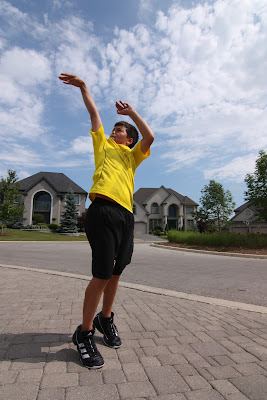Sometimes fate is a funny thing. I was lucky enough to visit Chicago, for the first time, with my 9 year old daughter this summer. We did the usual touristy things like visiting the Aquarium, seeing Navy Pier, Millenium Park, and of course, trying
Garrett's Chicago Mix Popcorn.
If you're not familiar, Chicago Mix is a blend of sweet caramel corn and savoury cheese corn. I'm usually a strictly sweets lover, so when I first heard what the combination was, I was pretty wary. But, walking into Garrett's and smelling the freshly popped corn, I was willing to try a sample.
Experiencing the Chicago Mix is probably like what Mr.
Reese first experienced when he put together chocolate and peanut butter - a match made in heaven. Somehow the sweet and savoury create a synergy that each on its own doesn't quite reach. That bag of warm, freshly popped Chicago Mix was one of the best things we have ever had! Sadly, in Canada, the difficulty in getting Garrett's, although remotely possible, is extremely expensive, circuitous, and certainly not fresh when it arrives.
Here's where fate comes in. . .
This week, on a random trip to our local
Costco, way off in the back corner, amongst pallets of bottled water and toilet paper I literally walked into a small display of
Cretors Chicago Mix Popcorn!
 G.H. Cretor?
G.H. Cretor?
Admittedly, I'd never heard of Cretor's before, so I hesitantly turned the bag over, not believing anything could come close to Garrett's. The bag and label certainly was enticing, evoking old time marketing. Cretor's also had the mandatory backstory, actually laying claim to inventing the popcorn machine in 1885. They also make their own caramel in old school copper kettles and melt their own cheddar cheese (no artificial powder!) for the cheese corn. Finally they had all the right buzz words - Gluten free, Kosher (although I'm not Jewish), and "all natural".
How's It Taste?
With little cajoling from the kids, I threw a bag into the cart, and as soon as we got home, broke into it - for scientific research only. My initial impression was certainly positive. The kernels were
all fully popped and extremely large mushroom style. In fact, I couldn't find
any unpopped kernels at the bottom of the bag.
Being a sweets guy, I tried the caramel corn on its own first. Impressive. It had a nice fresh crunch to the outside, then almost melted beneath that coating my mouth with buttery sweetness. For a bagged product, this was pretty good.
I hesitantly threw a cheese corn piece into my mouth. I looked at my hands first - NO orange powder residue! Nice. The cheese corn was just salty enough, and again nice and fresh. No sogginess to be found.
Finally I popped a combination of several of each, the way that Mr Garrett and Mr Cretor intended. The blend of sweet and savoury was just right, and evoked memories of that fresh stuff in Chicago. Of course it wasn't warm from being just popped, but came awfully close. I think I've found a new go-to snack; until I can find another excuse to visit Chicago!
Full Disclosure- I was not paid by anyone to review either product (sadly) and purchased all product on my own. (although if anyone wants to send me more Chicago Mix, I'd be happy to eat it up!)
So, which side are you on - Garrett's or Cretor's? Let me know!















